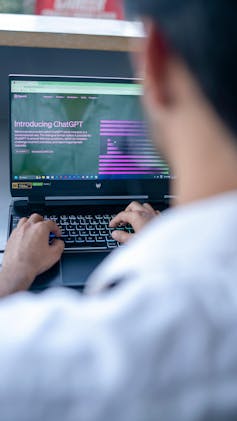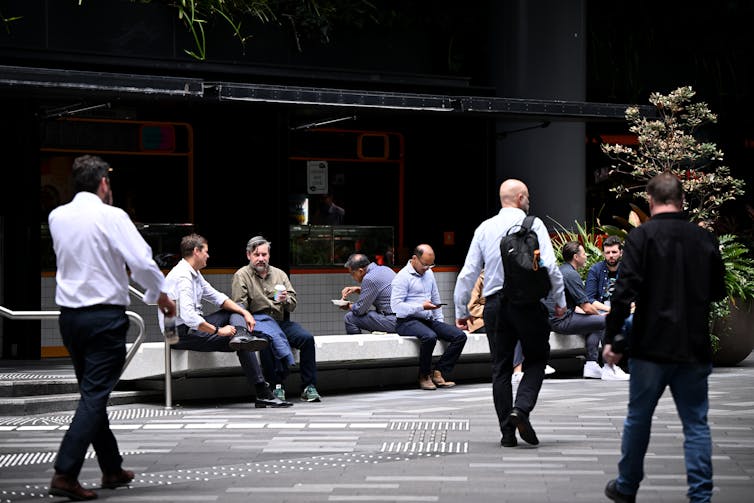Australian businesses have actually been slow to adopt AI, survey finds
- Written by Stan Karanasios, Professor in Information Systems, The University of Queensland

Over the past few years, we have repeatedly been told artificial intelligence (AI) is coming for our jobs.
In May last year, the International Monetary Fund warned[1] the technology was hitting labour markets like a “tsunami”. Many of the tech giants behind the technology have been making their own confident predictions[2] about which jobs will be wiped out first[3].
Yet inside many Australian firms, the reality is much less dramatic.
Last week, the Reserve Bank of Australia released the findings from a 2025 survey[4] of 100 medium and large-sized firms, which sought to understand how technology investments have been affecting the way businesses run. It found enterprise-wide AI transformation was the exception rather than the norm.
This presents a strange mismatch: a loud global story about an AI “jobpocalypse[5]”, and a much quieter story inside firms about experiments, pilots and a lot of waiting around for real productivity gains to show up. The Reserve Bank’s report[6] helps explain why.
Laying the groundwork
Australian firms haven’t been ignoring AI and technology. The report notes that over the past decade, total IT investment has grown by almost 80%, faster than other types of capital investment.
Much of that has gone into software, cybersecurity, cloud and upgrading internal systems such as customer relationship management and enterprise resource planning platforms.
While these investments are mostly about keeping the lights on and do not deliver big productivity pay offs on their own, they are essential groundwork to make firms’ systems and processes ready for AI.
‘Minimal’ use of AI
AI is now starting to move up the priority list. About two-thirds of firms surveyed said they have adopted AI “in some form”.
But for the largest group – representing nearly 40% of all respondents – this use was still “minimal”.

The most common use cases were tasks such as summarising emails or drafting text using off-the-shelf-products like Microsoft Copilot or ChatGPT.
Just over 20% of all firms reported “moderate” adoption, using AI to assist with tasks such as demand forecasting or inventory management.
And a small frontier group – less than 10% of all firms – said they had embedded AI into more advanced processes such as fraud detection.
Impact on jobs
Asked about jobs and the future, companies said AI and automation would likely save some labour, particularly on traditionally time-consuming tasks. But they didn’t expect it to cause catastrophic job losses.
Around half said they expected AI and machine learning would lead to a modest reduction in headcount over the next three years.
Firms planning to reduce their headcount expected to do so through natural attrition (employees resigning or retiring), lower intake of new staff, and redundancies.
Routine finance, administration and contact centre work were seen as most at risk of being automated. But firms also said AI would likely create demand for new roles related to the technology – such as in cybersecurity and redesigning processes.
Why are Australian firms so slow?
The Reserve Bank’s findings align with other reports showing Australia as a cautious adopter[8] of AI when compared, for example, to the United States[9].
Global report cards on AI adoption[10] and innovation[11] more broadly consistently place Australia behind many other advanced economies.
A few key themes stand out from the Reserve Bank’s survey and other international evidence.
First, much of Australia’s recent technology investment has gone into cybersecurity, compliance, legacy system upgrades, data quality improvements and cloud migration. This is a necessary first step before AI investments.
Second, many firms have been struggling to hire the skills needed to drive AI transformation, such as data engineers and data scientists.
And third, Australia’s business culture is cautious[12], with low trust[13] and high levels of concern about AI. Adding to this, individuals’ “shadow” use[14] of AI tools (without telling their bosses) can mask the true extent of the technology’s adoption.

Do Australian firms need more support?
If Australian businesses want to move beyond “ChatGPT for emails”, evidence points to several practical steps they and governments can make.
Better engagement of company boards[16] is crucial for moving beyond shallow pilots of digital technology, especially when workers distrust AI and directors see it as a risk. Providing evidence of more successful use cases is an important part of this shift.
Australia also needs to invest in lifting AI skills across the workforce, with a particular focus on reskilling workers and preparing for the likely decline in entry-level jobs[17] for young people.
The report indicates firms see the uncertain regulatory environment as a major barrier. The goal should be to have clear, risk-based rules that make safe experimentation easier.
Without these, firms are effectively told two things at once: “move fast to stay competitive” and “don’t you dare breach privacy, copyright or ethics”.
Read more: AI 'workslop' is creating unnecessary extra work. Here's how we can stop it[18]
Brace for a bumpy ride
It appears we may not yet be racing toward a world without workers, but rather a messy and uneven transition.
The number of AI firms in Australia has grown substantially[19], and there is clear momentum and optimism.
For now, however, many businesses are still working out how to make AI useful, embed it into workflows and manage its risks. Their biggest complaints are about ambiguous regulation and skills shortages – not having too many humans.
References
- ^ warned (www.reuters.com)
- ^ predictions (www.axios.com)
- ^ wiped out first (www.businessinsider.com)
- ^ survey (www.rba.gov.au)
- ^ jobpocalypse (www.ft.com)
- ^ report (www.rba.gov.au)
- ^ Viralyft/Pexels (www.pexels.com)
- ^ cautious adopter (kpmg.com)
- ^ United States (www.cnbc.com)
- ^ AI adoption (www.aph.gov.au)
- ^ innovation (www.wipo.int)
- ^ cautious (hai.stanford.edu)
- ^ low trust (kpmg.com)
- ^ individuals’ “shadow” use (theconversation.com)
- ^ Bianca De Marchi/AAP (photos.aap.com.au)
- ^ engagement of company boards (doi.org)
- ^ decline in entry-level jobs (www.npr.org)
- ^ AI 'workslop' is creating unnecessary extra work. Here's how we can stop it (theconversation.com)
- ^ grown substantially (www.industry.gov.au)

















